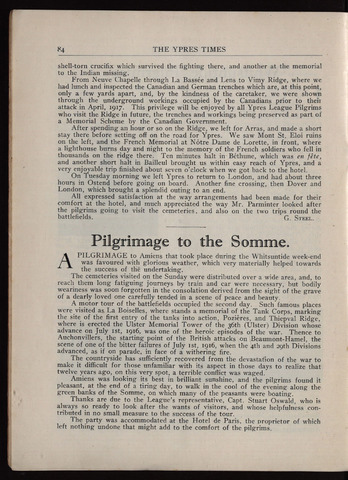Pilgrimage to the Somme.
84
THE YPRES TIMES
shell-torn crucifix which survived the fighting there, and another at the memorial
to the Indian missing.
From Neuve Chapelle through La Bassée and Lens to Vimy Ridge, where we
had lunch and inspected the Canadian and German trenches which are, at this point,
only a few yards apart, and, by the kindness of the caretaker, we were shown
through the underground workings occupied by the Canadians prior to their
attack in April, 1917. This privilege will be enjoyed by all Ypres League Pilgrims
who visit the Ridge in future, the trenches and workings being preserved as part of
a Memorial Scheme by the Canadian Government.
After spending an hour or so on the Ridge, we left for Arras, and made a short
stay there before setting off on the road for Ypres. We saw Mont St. Eloi ruins
on the left, and the French Memorial at Nótre Dame de Lorette, in front, where
a lighthouse burns day and night to the memory of the French soldiers who fell in
thousands on the ridge there. Ten minutes halt in Béthune, which was en fête,
and another short halt in Bailleul brought us within easy reach of Ypres, and a
very enjoyable trip finished about seven o'clock when we got back to the hotel.
On Tuesday morning we left Ypres to return to London, and had about three
hours in Ostend before going on board. Another fine crossing, then Dover and
London, which brought a splendid outing to an end.
All expressed satisfaction at the way arrangements had been made for their
comfort at the hotel, and much appreciated the way Mr. Parminter looked after
the pilgrims going to visit the cemeteries, and also on the two trips round the
PILGRIMAGE to Amiens that took place during the Whitsuntide week-end
was favoured with glorious weather, which very materially helped towards
the success of the undertaking.
The cemeteries visited on the Sunday were distributed over a wide area, and, to
reach them long fatiguing journeys by train and car were necessary, but bodily
weariness was soon forgotten in the consolation derived from the sight of the grave
of a dearly loved one carefully tended in a scene of peace and beauty.
A motor tour of the battlefields occupied the second day. Such famous places
were visited as La Boiselles, where stands a memorial of the Tank Corps, marking
the site of the first entry of the tanks into action, Pozières, and Thiepval Ridge,
where is erected the Ulster Memorial Tower of the 36th (Ulster) Division whose
advance on July 1st, 1916, was one of the heroic episodes of the war. Thence to
Auchonvillers, the starting point of the British attacks on Beaumont-Hamel, the
scene of one of the bitter failures of July 1st, 1916, when the 4th and 29th Divisions
advanced, as if on parade, in face of a withering fire.
The countryside has sufficiently recovered from the devastation of the war to
make it difficult for those unfamiliar with its aspect in those days to realize that
twelve years ago, on this very spot, a terrible conflict was waged.
Amiens was looking its best in brilliant sunshine, and the pilgrims found it
pleasant, at the end of a tiring day, to walk in the cool of the evening along the
green banks of the Somme, on which many of the peasants were boating.
Thanks are due to the League's representative, Capt. Stuart Oswald, who is
always so ready to look after the wants of visitors, and whose helpfulness con
tributed in no small measure to the success of the tour.
The party was accommodated at the Hotel de Paris, the proprietor of which
left nothing undone that might add to the comfort of the pilgrims.
battlefields.
G. Steel.

